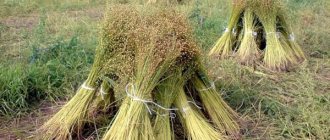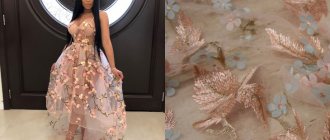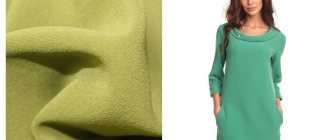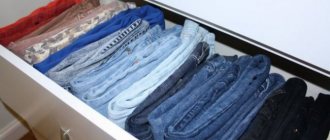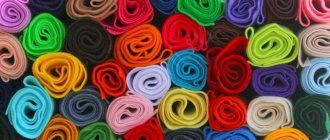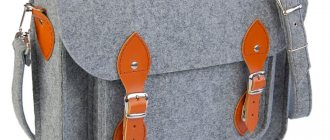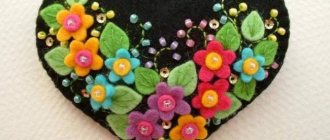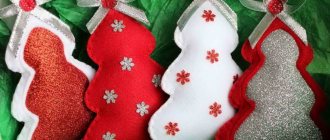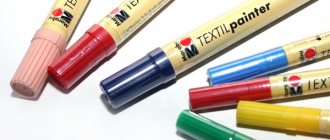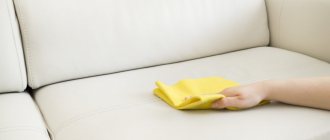Felt is a non-woven material made by felting wool or synthetic fibers. According to its characteristics, the fabric is similar to felt, but has a more delicate texture and softness. Initially, felt was created from rabbit and goat fluff to create warm clothing and household items. Today, there are many types of raw materials for producing linen, which is often used in handicrafts for making crafts due to the variety of shades. The material obtained industrially will also be used to create blankets, linings for demi-season clothing, and sewing coats.
Features and characteristics, description
Felt is a homogeneous material of mechanical origin. It is a dense mass of felted fibers; there are no intertwining threads in the structure - the fabric is a non-woven type of fabric.
Some types are produced by combining frame material (wool or rope) - they are used to create warm clothing and household products.
The material has a long history; it was originally used for sewing warm clothes and shoes. Today it is more often used in needlework, sewing coats, hats, and blankets. The fabric has high decorative value and plasticity. Natural canvas made of felt and soft cotton has a significant drawback - it is susceptible to deformation when wet, and is affected by moths if storage rules are not followed.
Felt is sometimes understood as thin felt or yarn after a dry felting process. These types of fabrics are almost impossible to distinguish visually; the materials have the same technical characteristics.
What does it consist of, what does it look like
The main raw material for production is soft wool or fluff collected from animals (sheep, goats, rabbits). To enhance the strength and technical properties of the fabric, synthetic fibers and dyes can also be used. After production, the material is a homogeneous canvas with a single color or print on the surface. There is a small pile on top, its height depends on the wool content in the composition. Regardless of the origin of the fibers, they are not intertwined with each other, but felted - this allows you to achieve a unique texture and strength.
Properties and quality, density of natural
It has high thermal insulation properties, which is important for sewing warm clothes and shoes. Natural material is characterized by the presence of pile on the surface; its height varies from 0.5 to 12 mm. Real wool felt is durable and has the ability to repel water and dirt. However, it is quite expensive and can become deformed during prolonged contact with water.
The canvas can be strong and uniform, or loose (this type is used to create crafts and soft toys).
Density differs depending on production technology. Wool blend has a smooth surface, the material is very pleasant to the touch. It is more plastic and soft - these properties are actively used in needlework and making rugs.
The most common type is synthetic. It can be distinguished by its wide range of colors and shiny surface. To create such fabric, they use not only natural wool fibers (angora, Peruvian sheep wool), but also acrylic and polyester. The density of the fabric may vary.
Production technology and manufacturing of felt material
Modern felt is made by machine, production is fully automated. Standard technological process:
- Wool or synthetic fibers are untangled using sharp teeth on a loom.
- The prepared mass is passed through the shafts, pulling it into a straight line.
- Recycled fibers in the form of layers are stacked on top of each other, treated with special needles with notches - this allows tangling to be achieved.
- Several combined layers are passed through the press rollers, after which a homogeneous mass up to a centimeter thick is formed.
- The compressed canvas is cut into sheets or immediately used for the production of blanks of various shapes (for creating caps, hats, stockings).
The wool felting process can be dry or wet. The first method is usually used when working with natural fibers. Felt produced by felting is considered the most expensive and warm.
Felting is a method of dry felting using a needle. It is used for the production of bulky fabric, processing of wool and down, as well as the creation of costume jewelry and soft toys.
Kinds
You can find various types on the fabric market. They differ in composition, thickness and size of the pile. Each type has unique properties and application features. When choosing a fabric for a specific job, you should take into account the wool and synthetic content, as well as physical properties. The composition is always indicated on the product tag or in the annotation for the product.
The thickness of the material varies from 1 to 4 mm, the largest production is located in China and Korea.
Polyester
To create this, only polyester fibers are used. They have the ability to take any shape, high strength and wear resistance. The canvas can be painted in various shades, the color saturation is maintained with frequent contact with water and cleaning. 100% polyester fabric is used for the manufacture of products for active wear, soft toys, appliqués on clothing.
Synthetic
This type has gained great popularity due to its high strength and low cost. The material consists entirely of acrylic or polyester fibers, the canvases are presented in a wide range of colors. Large Korean manufacturers have up to 144 shades. A special anti-reflective solution is applied to the surface to reduce gloss.
The advantages of synthetic fibers are environmental friendliness, hypoallergenicity and strength of the fibers (they do not fly apart during the cutting process).
Artificial or acrylic
A common type that is made from 100% acrylic is recycled plastic. The material has a rich color palette; disadvantages include surface gloss and poor ductility. Acrylic is not subject to shrinkage, retains its shape well and does not fade. The fabric is used to create stuffed toys, but is not used for sewing clothes. Artificial felt does not tolerate high temperatures; low-quality canvases may be transparent, which is important to consider when choosing a material for needlework.
Woolen
This is the most expensive type, the high cost is due to the content of natural fibers and the complex manufacturing method. The material has a uniform texture consisting of large fibers of wool (sheep, goat or rabbit). The fabric is very warm and pleasant to the touch. May have different densities depending on the method of creation.
Dense wool felt practically does not crumble and does not deform under the influence of external factors.
Clothes and shoes made from it last a long time and can withstand repeated cleaning. Soft fabrics are used to create jewelry, decorative elements and crafts.
The properties of wool largely depend on the raw materials used. The most valuable material is made from sheep or rabbit down.
Wool blend
It is made by felting mixed fibers; more often, a combination of natural wool and viscose or polyester is found. The material has a texture that is pleasant to the touch and has a decorative appearance. The surface is smooth and silky, this fabric is plastic and soft. Wool blend retains its shape well, which is used for making toys. The fabrics are used to make blankets, rugs and house shoes. The advantages include excellent physical characteristics and variability of application, a wide range of shades.
Simulated
A distinctive feature of this felt is its unique molding characteristics. The material takes almost any shape and does not deform during operation. This property is achieved by treating the fabric with special impregnating solutions; after drying, the fibers take on the required geometry and do not lose their decorative appearance.
Synthetic fibers are usually used for the manufacture of simulated fibers, since they are characterized by increased density and ductility.
Eco
This type is still gaining popularity in the market; environmentally friendly raw materials are used to create the canvases. The basis of the fiber is polyester, obtained during the processing of plastic. Externally, the material resembles traditional synthetic, but is characterized by increased rigidity. The largest production facilities are located in the USA, so the cost of the material is quite high. The fabric is highly durable and can be dyed and shaped. Due to its high price, eco-felt is used to create small decorative jewelry, keychains and interior design elements.
Thin
This is the general name for felt materials up to 5 mm thick. The fabric is characterized by high plasticity and the ability to take any necessary shape. This quality is used to make decorative items, toys and designer jewelry.
Thin cloth is also used for sewing shoe inserts and warm coats.
To prepare the fabric, both wool and various synthetic fibers can be used. Read about beige fabric for Etro Max furniture at this link.
As you wear it, felt clothing shrinks a little and becomes thinner to the touch. This does not affect the technical characteristics of the material in any way; it continues to retain heat well and prevent moisture from entering.
Dense
By such felt we mean material thicker than 5 mm. It has a hard texture and does not take shape well without special treatment. Produced by felting wool or synthetic fibers in large sizes. The fabric is recommended for creating crafts, sewing warm shoes and decorative items. Thick fabrics such as taslan and tiara are difficult to work with and require special needles and a powerful overlocker to stitch the edges. Disadvantage: poor ductility, high probability of fiber delamination during processing.
Bamboo
This is a hard and dense material made from bamboo fiber. To increase plasticity, viscose is added to the fabric. Felt of this type has antibacterial properties, is pleasant to the touch, and is available in a wide range of colors on the market.
The canvas has a number of disadvantages - high cost, inability to wash.
To remove dirt from the surface, only dry cleaning is suitable. Bamboo is used only for decorative purposes - to create toys, interior items and decorations.
What they are made of and the production process
Fibers of various origins are used as raw materials for making felt:
- Naturals and their composition.
There are three subtypes of this type of material:
- Down felt. The softest, most delicate to the touch and in terms of consumer characteristics is considered the best. For its production, the downy component of the skin of a hare, rabbit, fox, muskrat and other small animals is used.
- Wool material felt. This type is rougher to the touch than the previous one, heavier and stiffer, but in terms of consumer properties it is not inferior to it, and in some respects, on the contrary, it is superior, in particular in strength. Made from sheep and goat wool of various qualities.
- Downy wool felt. Made from a mixture of down and wool in various ratios. They combine fibers of the same origin (for example, down and goat hair) and from different animals. Consumer properties depend on the percentage of fibers: if there is more fluff, then the material has qualities close to down felt, but if wool predominates, then vice versa.
- Synthetic.
There are also two subspecies here:
- acrylic felt.
It is a product of plastic processing, so it differs not for the better - it feels hard, holds its shape well, but does not bend well and is too rough;
- polyester felt.
On the contrary, it is a very soft and pliable material, holds its shape well, has excellent consumer properties and is inexpensive.
- Mixed.
Read about: synthetic and natural insulation: Thinsulate and down
Produced from a mixture of synthetic and natural fibers in varying percentages. The quality of the resulting material directly depends on its composition.
The production process consists of several stages. If we are talking about natural raw materials, then first they are thoroughly cleaned, processed on furrowing machines, and sorted. The next stage is rolling, when at high temperatures and mechanical action the fibers fall together, giving the canvas the necessary density and thickness.
Then - molding, dyeing, and the final stage - finishing, when loose coarse fibers are removed from the surface of the fabric.
Scope of application: what is sewn from fabric, what is it used for
It is one of the most versatile wool materials. It is actively used for the manufacture of the following products:
- warm demi-season clothing, shoes and insoles;
- keychains, jewelry, interior design items;
- soft stuffed toys, crafts for children;
- household items - rugs, carpets, blankets.
The variability of the fabric is due to the use of different raw materials (wool, synthetics, bamboo fibers, polyester, acrylic). Note the wide range of colors of this material, the range of thickness and different textures.
When choosing a canvas for solving specific problems, you should take into account the composition, texture and ability to retain shape.
How to work with fiber for crafts, how to cut
Felt is loved by needlewomen for its versatility and decorative appearance. The material is easy to work with, it is well exposed to mechanical and chemical influences. The greatest difficulty is cutting this fabric, since the edges can delaminate and the fibers come out of the total mass. To avoid this, you should use a special sharpened cutter, and then wrap the edges manually or with an overlocker.
To cut the cloth, you can use well-sharpened tailor's scissors.
House for dolls made of fabric and felt
Like other materials created by felting, felt is suitable for creating children's toys. You can use canvas to create printed letters for teaching children the alphabet, as well as playhouses. It is best to use thick felt for this purpose. Mark the lines of the main elements of the house on the canvas, cut them off using a cutter or scissors. After this, overcast the edges, glue or sew all the parts into a single structure.
Advantages and disadvantages
The advantages of felt include that it can withstand loads along the seams, the edges do not fray, and as far as I know, natural felt does not cause allergic reactions, does not have a reverse side, it can be glued, cut, and sewed. Felt fabric has a rich range of colors, which is very good for creating crafts from it. It does not require special processing.
And of course, where there are advantages, there are also disadvantages: after improper washing, it can lose its shape, when wet it has an unpleasant odor, and in further use, pellets may form and will be disheveled.
Care instructions
Requires careful care, which allows you to maintain the attractive appearance and technical properties of the material. Helpful Tips:
- It is preferable to use dry cleaning with a special brush;
- To remove stubborn dirt from the surface, you can use special cleaning products;
- Machine washing is prohibited; for cleaning, hand wash only;
- Drying is recommended away from heat sources and direct sunlight.
Products should not be wrung out after exposure to water. It is best to use steam cleaning or take the item to a special service where the necessary requirements are met.
Is it possible to iron
Clothes or flat toys can be ironed after completely drying. This allows you to avoid the appearance of deformations on the surface and bruises. It is best to use the minimum temperature and place a thin cloth or gauze on top. This material will tell you about Modelini clothes from Ivanovo.
The best method for ironing is using steam.
How to make felt soft and hard
The texture and density of the material is acquired during the production process. At home, you can increase the softness of the fabric by additional felting or using steam - this allows you to achieve a certain shape when creating toys and clothes. To increase rigidity, starch is used - it is applied to the surface for several minutes, then cleaned with a brush. In addition, you can initially take dense material, soften it with steam and wait for the primary density to return. Read about knitwear from Ivanovo and Zlata’s clothing catalog here.
How to shape
To give a specific shape to fabric, two main methods are used: using steam and water. The second method can lead to a deterioration in appearance, so it must be used carefully. The optimal solution for shaping is to purchase felt with minimal rigidity.
What fabric does it stick to?
The material is often used to create applications and decorative compositions. To attach the elements, you can use special Velcro or glue. The greatest gluing density can be achieved by combining wool felt and natural cotton, since the fibers are attached to each other during the process.
To make small design elements, you can use the felting method. With its help, you can fasten several parts of the same texture and texture.
Is it possible to felt felt on wool?
Felting is often used in needlework - this method is used to make crafts, toys for children, and key chains. Natural material can be felted with down or sheep wool. This allows you to achieve the required volume and shape. This article will tell you about Roman blinds for a children's room.
The process takes quite a lot of time and requires certain skills and experience. Recommended for creating small products with many small decorative elements.
Application area
The scope of application of felt is unusually wide - it is used in:
- clothing production (outerwear, hats, shoes);
- automotive industry (upholstery, some parts, seals, etc.);
- machine industry (filters, seals, lubricants and polishing materials);
- furniture industry (as upholstery for upholstered furniture);
- production of goods for children (toys, decorative elements for children's rooms);
- for needlework.
Felt is also a popular material for bags, brooches, and jewelry, including handmade items.
How to replace felt for needlework - similar analogues
Real cloth has a high cost, so there are a number of materials that can be used as analogues. The most popular of them:
- viscose;
- thin felt;
- wool;
- prefelt;
- fleece;
- drape
The variability of such materials allows you to achieve different textures of the product and color solutions. The toy, created from several types of fabric, is distinguished by its beautiful appearance and durability. In addition, polystyrene foam, foamiran (foam rubber), pieces of leather, cardboard, buttons and plastic can be used as additional elements. Find out how to calculate the size of a tablecloth for a table here.
Felt and felt: what is the difference, what is the difference, what is better
Both materials are produced using the same technology. Thin felt is practically indistinguishable from felt, so outwardly it is easy to confuse the cloth. These fabrics can be distinguished only by touch, as well as by the presence of fibers on the surface.
For needlework and tailoring, both types of cloth have the same value and are full-fledged analogues.
Felt is always denser and stiffer, has a characteristic wool pile on top, and can also be quite thick.
There are three main types of cloth used in felting: felt, felt and prefelt. They differ only in thickness and density.
Caring for felt products
- To ensure that all felt items last a long time, they should never be washed in a washing machine. Dry cleaning is best, which can be done with either a soft brush, or a sticky roller can be used to remove fine lint.
- If dirt gets on the felt material, let it dry and then clean it with a brush.
- If there is a stain left, only then can you use a delicate hand wash; you can also add a stain remover or ammonia (exactly on the stain).
- If this is the first wash, it is better to use cool water so that the fabric does not fade, it does not twist, it shrinks easily, or the water drains on its own.
- To prevent the felt fabric from fading, and this is possible, there is no need to dry it in the sun.
